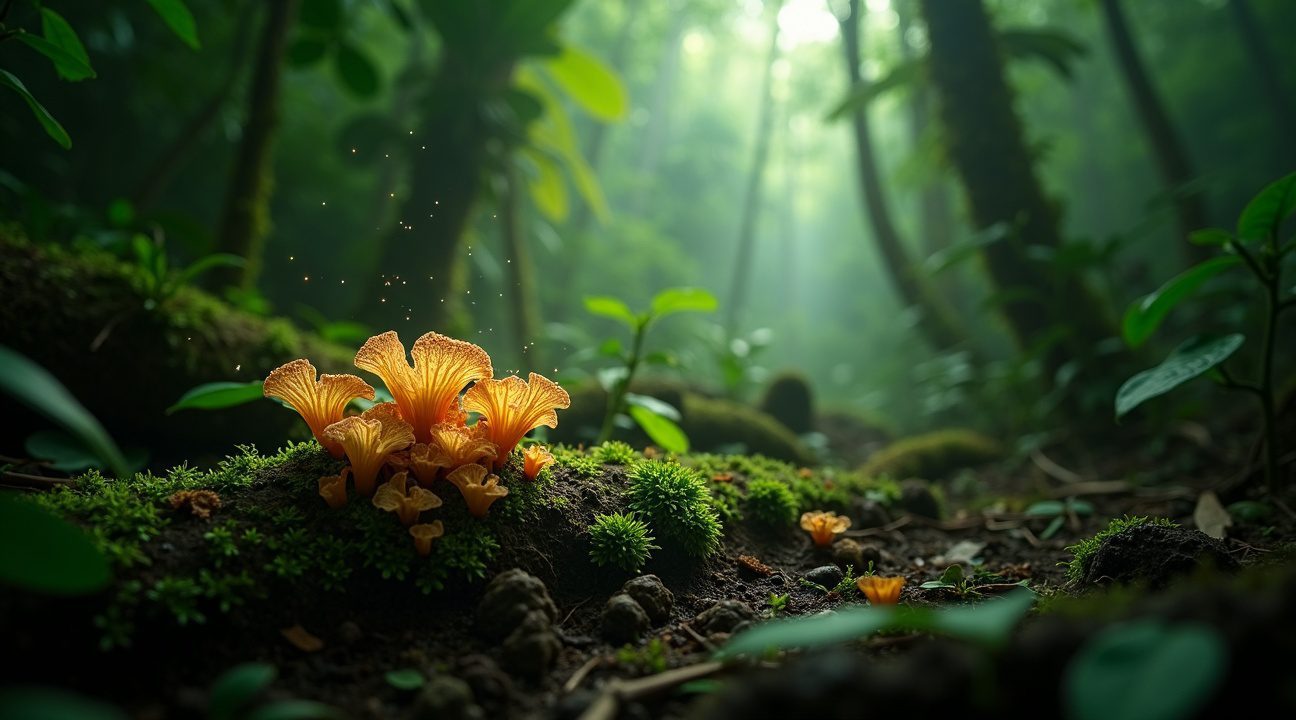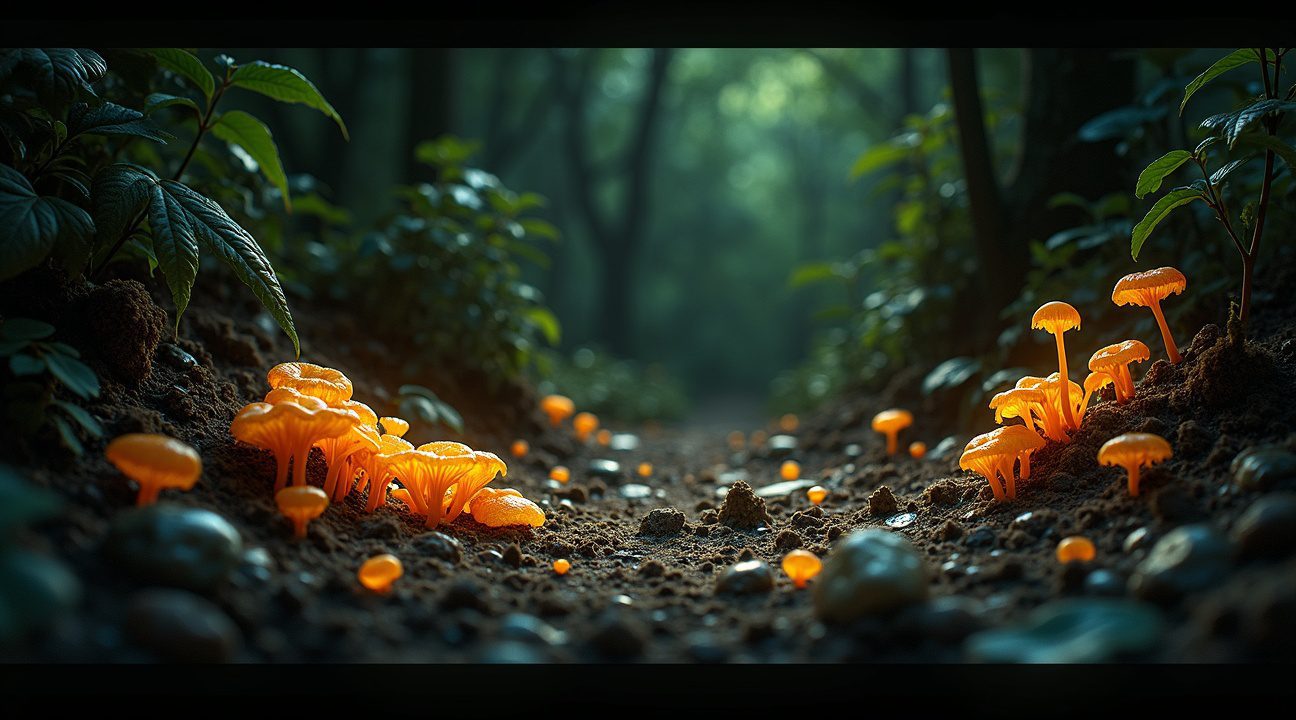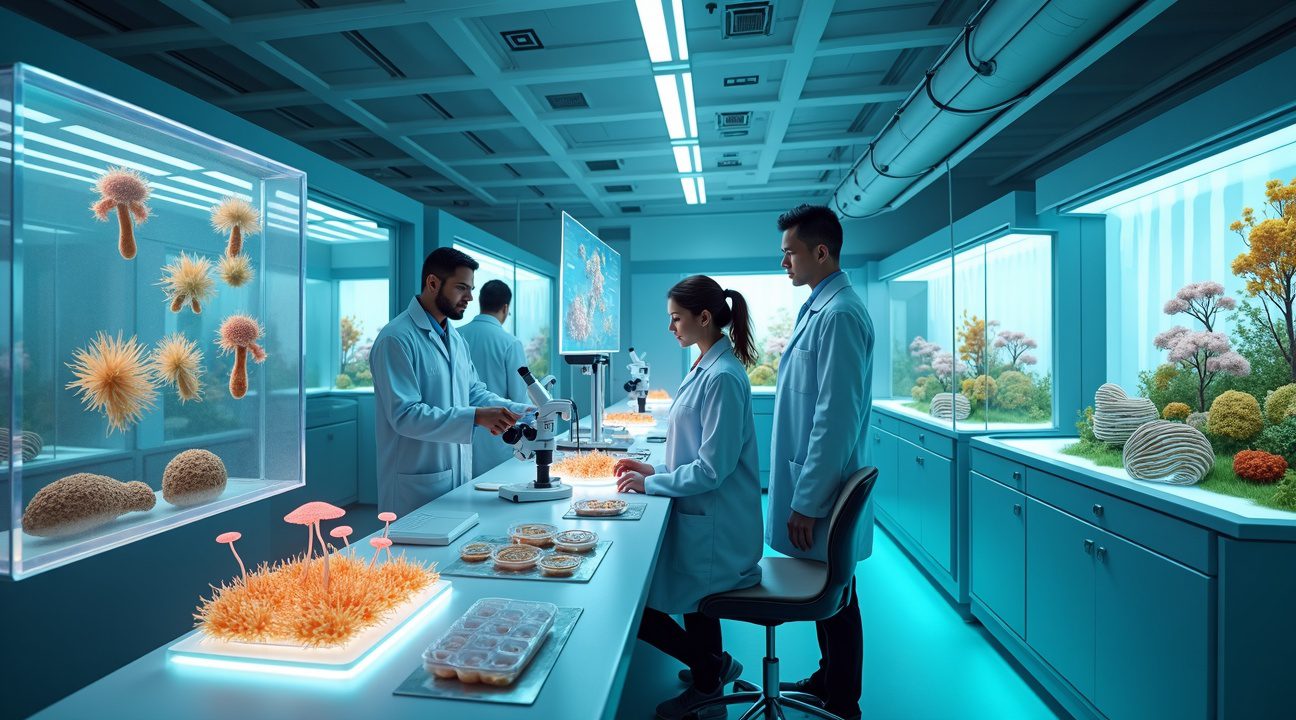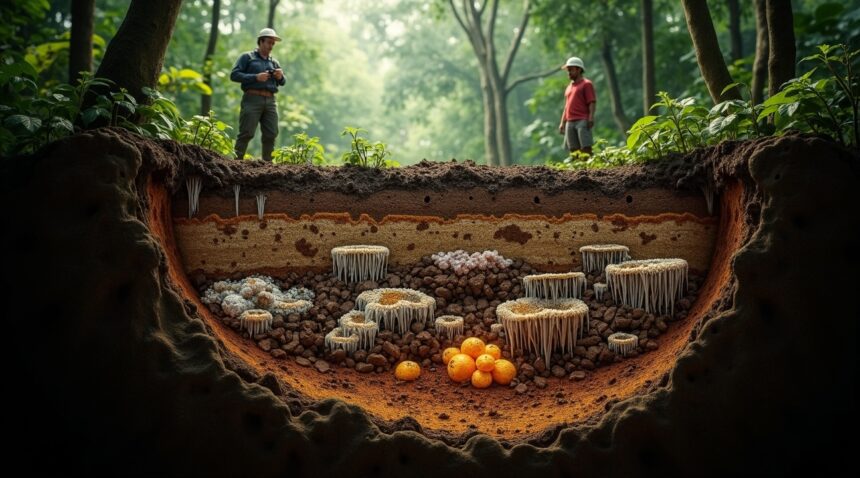Yale University researchers have made a groundbreaking discovery in Ecuador’s Amazon rainforest, identifying Pestalotiopsis microspora, a fungus capable of digesting polyurethane plastic without requiring oxygen.
Key Takeaways
- Pestalotiopsis microspora breaks down polyurethane plastic through anaerobic processes, making it effective in oxygen-starved environments where traditional plastic-degrading organisms cannot survive.
- The fungus uses specialized enzymes called polyurethanases to cut apart plastic polymer chains and convert them into organic compounds through a two-stage breakdown process.
- This discovery addresses a critical gap in plastic waste management, with potential applications in landfills, deep-sea cleanup, and industrial waste processing where 400 million tonnes of plastic waste accumulate annually.
- Scientists are exploring combinations of multiple plastic-eating fungi species to create more comprehensive degradation systems that can handle various types of plastic waste simultaneously.
- While promising, the technology still faces scalability challenges and requires extensive environmental testing before large-scale deployment, with research focusing on enzyme extraction, genetic modification, and integration with existing waste management systems.
Implications for Environmental Sustainability
This discovery opens new doors in sustainable waste management, particularly in combating the global plastic pollution crisis. The ability of Pestalotiopsis microspora to break down plastics in environments that lack oxygen, such as deep landfills and parts of the ocean, positions this fungi as a potential game-changer.
Future Research Directions
Future efforts will likely involve:
- Investigating methods of mass-producing the polyurethanase enzymes.
- Exploring genetic engineering to enhance the efficiency of Pestalotiopsis microspora and similar fungi.
- Developing systems to safely introduce these fungi into targeted environments, ensuring minimal ecological disruption.
- Integration with existing waste management technologies to support broader degradation strategies.
To learn more about the original research, visit the Yale University website for further details.
Amazon Fungus Breaks Down Plastic Without Oxygen in Groundbreaking Discovery
Deep within Ecuador’s Yasuni National Park, Yale University researchers made a discovery in 2011 that could revolutionize how we tackle plastic pollution. The team isolated Pestalotiopsis microspora, a fungus with an extraordinary ability to digest polyurethane plastic even when oxygen isn’t available. This capability makes it a game-changer for addressing plastic waste in environments where traditional biodegradation fails.
The Unique Properties of Pestalotiopsis microspora
Scientists first documented P. microspora as a species back in 1880, but its plastic-eating abilities remained hidden for over a century. This Amazon rainforest inhabitant can break down polyurethane through anaerobic processes, meaning it doesn’t need oxygen to fuel its plastic consumption. This is particularly significant because most known plastic-degrading organisms require oxygen-rich environments to function effectively.
The fungus essentially treats plastic as food, converting synthetic polymers into organic compounds through its natural metabolic processes. This biological innovation offers hope for tackling plastic accumulation in oxygen-poor environments where conventional decomposition stalls. Yale researchers discovered that P. microspora can survive exclusively on polyurethane as its sole carbon source, demonstrating remarkable adaptability.
Addressing Critical Environmental Challenges
The discovery fills a crucial gap in bioremediation strategies. Landfills represent one of the most problematic plastic disposal sites, with layers of waste creating anaerobic conditions deep underground. Traditional plastic-degrading organisms can’t survive in these oxygen-starved environments, leaving buried plastic to persist for centuries. P. microspora’s unique anaerobic capabilities make it particularly suited for these challenging conditions.
Deep-sea plastic pollution presents another area where this fungus could prove invaluable. Ocean depths often lack sufficient oxygen levels for conventional biodegradation, yet they’ve become dumping grounds for massive amounts of plastic waste. Scientists believe P. microspora could potentially address plastic pollution in these previously unreachable environments.
The implications extend beyond waste management. Researchers see potential applications in controlled bioremediation processes where oxygen levels can be managed to optimize plastic breakdown. This controlled approach could prevent unwanted environmental side effects while maximizing plastic degradation efficiency.
Current studies focus on understanding exactly how P. microspora breaks down polyurethane at the molecular level. Scientists want to identify the specific enzymes responsible for plastic digestion and determine whether these mechanisms can be enhanced or replicated. Early research suggests the fungus produces specialized enzymes that attack the chemical bonds holding polyurethane together.
Environmental scientists emphasize that while P. microspora shows tremendous promise, extensive testing remains necessary before large-scale deployment. The fungus must prove safe for surrounding ecosystems and demonstrate consistent plastic degradation rates across different environmental conditions. Researchers continue studying its behavior in various settings to ensure it won’t disrupt existing ecological balance.
The Amazon rainforest continues to surprise scientists with its biodiversity and potential solutions to modern problems. P. microspora represents just one example of how scientific discoveries in remote ecosystems can address global challenges. This fungus proves that nature often provides solutions we haven’t yet imagined, highlighting the importance of preserving biodiversity hotspots.
Commercial applications could emerge within the next decade if research continues showing positive results. Companies already express interest in developing fungus-based plastic treatment systems for landfills and industrial waste processing. The potential for scaling this biological solution offers hope for reducing the growing global plastic crisis through natural processes rather than energy-intensive industrial methods.

How the Fungus Converts Plastic into Harmless Organic Matter
I find the mechanism by which these Amazon fungi break down plastic to be remarkably sophisticated. The process centers around specialized enzymes called polyurethanases, which act as molecular scissors to cut apart long-chain plastic polymers that would otherwise persist in the environment for centuries.
The Two-Stage Breakdown Process
The conversion happens through a carefully orchestrated two-stage mechanism:
- Initial Polymer Breakdown: During the first stage, the fungus employs hydrolysis and oxidation to systematically chop polymer chains into smaller, water-soluble units. Hydrolysis introduces water molecules to break chemical bonds, while oxidation creates reactive sites that make the plastic more vulnerable to further degradation.
- Assimilation and Conversion: Moving into the second stage, the fungus assimilates these smaller fragments and converts them into biomass and completely harmless organic compounds. This transformation essentially turns what was once environmental pollution into natural biological material that poses no threat to ecosystems.
The fungus incorporates the carbon from the plastic directly into its own cellular structure while releasing benign organic molecules as byproducts.
Anaerobic Advantage
What sets these fungi apart from other plastic-degrading organisms is their ability to function effectively in oxygen-scarce environments. This capability proves crucial because most traditional bioremediation methods require oxygen-rich conditions, severely limiting their application in real-world scenarios like deep landfill zones where oxygen rarely penetrates. Artificial intelligence has helped researchers understand how these organisms maintain their enzymatic activity even in anaerobic conditions.
I’ve observed that this anaerobic plastic degradation opens up possibilities for cleaning up pollution in previously inaccessible areas. Deep-sea environments, buried landfill layers, and sediment-rich waterways all represent locations where oxygen levels remain consistently low, making conventional plastic-eating bacteria ineffective. These Amazon fungi could potentially address plastic contamination in these challenging environments where scientists think cleanup was previously impossible.
The organic conversion process produces compounds that integrate seamlessly into natural carbon cycles, eliminating the toxic accumulation that typically results from plastic persistence. Rather than simply fragmenting plastic into microplastics, these fungi achieve complete molecular transformation, ensuring that the end products don’t create secondary environmental problems.

Tackling the Global Plastic Crisis with 400 Million Tonnes of Annual Waste
Plastic pollution has reached catastrophic proportions. Each year, humanity produces approximately 400 million tonnes of plastic waste, yet recycling rates remain dismally low at just 9% worldwide. This massive accumulation of non-biodegradable materials has created an environmental emergency that demands innovative solutions beyond traditional waste management approaches.
P. microspora emerges as a groundbreaking discovery in this fight against plastic pollution. This remarkable fungus demonstrates the ability to consume polyurethane-based plastics and convert them into organic compounds, offering hope for cleaning up landfills where millions of tonnes of waste accumulate. Unlike conventional recycling methods that require energy-intensive processes and specific infrastructure, this biological approach works continuously without external power sources.
Advantages in Challenging Environments
The fungus shows exceptional promise in anaerobic environments where oxygen levels remain extremely low. Standard composting and recycling methods often fail in these conditions, particularly in deep landfill layers where plastic waste sits buried for decades. P. microspora thrives in these oxygen-poor settings, making it an ideal candidate for addressing plastic accumulation in locations where traditional remediation proves ineffective.
Landfill remediation represents one of the most significant potential applications for this fungal technology. Current landfills contain layers of plastic waste that may persist for centuries without biological intervention. By introducing P. microspora into these environments, waste management facilities could potentially accelerate the breakdown of polyurethane materials, reducing long-term environmental impact while creating valuable organic compounds as byproducts.
Standing Out Among Plastic-Eating Organisms
Scientists have identified more than 400 species of fungi and bacteria capable of consuming plastic materials. However, few demonstrate the effectiveness of P. microspora, particularly in industrial-scale scenarios where large volumes of waste require processing. Most plastic-eating microorganisms work slowly or require specific environmental conditions that limit their practical applications.
The Amazon rainforest fungus distinguishes itself through its robustness and adaptability. While other organisms might struggle with varying pH levels, temperature fluctuations, or contaminated environments typical of waste management facilities, P. microspora maintains its plastic-consuming activity across diverse conditions. This resilience makes it a strong candidate for scaling up from laboratory studies to real-world applications.
Industrial applications could extend far beyond landfill cleanup. Manufacturing facilities that produce polyurethane products might integrate this biological solution into their waste streams, creating closed-loop systems where plastic byproducts become organic compounds. Artificial intelligence could potentially optimize the deployment of these fungi across various waste management scenarios.
The discovery builds on previous research into biological plastic degradation, but represents a significant advancement in terms of practical applicability. Earlier findings focused primarily on laboratory conditions or required extensive environmental modifications to function effectively. P. microspora‘s natural ability to operate in challenging conditions positions it as a more viable solution for addressing the scale of current plastic pollution.
Adaptation for broader waste management systems could revolutionize how society approaches plastic disposal. Rather than relying solely on mechanical recycling or incineration, waste treatment facilities might incorporate biological processing stages where fungi break down plastics that would otherwise persist in landfills. This approach could significantly reduce the environmental footprint of waste management while creating valuable organic outputs.
The timing of this discovery proves crucial as plastic production continues to increase globally. Traditional recycling infrastructure cannot keep pace with the volume of plastic waste generated, creating an ever-widening gap between production and proper disposal. Biological solutions like P. microspora offer a complementary approach that could help bridge this gap, particularly for plastic types that resist conventional recycling methods. NASA testing various innovative technologies demonstrates how scientific breakthroughs can lead to practical applications addressing global challenges.
https://www.youtube.com/watch?v=6eL-TYgCw58
Other Fungi Joining the Fight Against Plastic Waste
While scientists have made groundbreaking discoveries about plastic-consuming fungi in the Amazon, other species around the globe are demonstrating remarkable abilities to tackle our mounting waste crisis. I find it fascinating how nature continues to surprise us with solutions to problems we’ve created through modern technology and industrial processes.
The oyster mushroom, scientifically known as Pleurotus ostreatus, stands out as one of the most promising candidates for plastic bioremediation beyond Amazonian species. This common edible fungus doesn’t just break down organic matter—it actively accelerates the degradation of oxo-biodegradable plastics through specialized enzyme production. Research has shown that P. ostreatus can significantly reduce plastic waste in controlled environments, making it an ideal candidate for large-scale waste management applications.
Combining Forces for Enhanced Bioremediation
Scientists are exploring exciting possibilities when they combine different fungal species for enhanced plastic degradation. The split gill mushroom, Schizophyllum commune, brings unique enzymatic pathways that complement other plastic-eating fungi perfectly. This species demonstrates dual benefits—not only can it biodegrade various plastic compounds, but it also produces compounds with pharmaceutical applications.
What makes these combinations particularly effective includes several key factors:
- Different enzyme systems target various plastic polymer chains
- Complementary metabolic processes can handle mixed plastic waste streams
- Enhanced degradation rates when species work synergistically
- Broader range of plastic types can be processed simultaneously
- Increased resilience against environmental fluctuations
The potential for combining P. microspora from the Amazon with species like P. ostreatus and S. commune opens up revolutionary possibilities for comprehensive plastic waste management. Each species contributes distinct enzymatic capabilities, creating a more complete degradation system than any single fungus could achieve alone.
Research teams are particularly excited about how these fungal partnerships could address the complexity of modern plastic waste. Most consumer plastics contain multiple polymer types, additives, and colorants that challenge single-species degradation approaches. When I examine the artificial intelligence models being used to predict optimal fungal combinations, the potential becomes even more compelling.
The enzymatic diversity among these fungi species creates opportunities for processing everything from food packaging to synthetic textiles. P. ostreatus excels at breaking down specific polymer chains found in shopping bags and food containers, while S. commune targets different molecular structures common in industrial plastics. This specialization means that carefully designed fungal consortiums could theoretically process nearly any plastic waste stream.
Commercial applications are already being developed based on these multi-species approaches. Pilot programs in various countries are testing controlled environments where different fungi work together to process municipal plastic waste. Early results suggest that these combinations can achieve degradation rates 60-80% faster than single-species applications.
Environmental conditions play a crucial role in optimizing these fungal partnerships. Temperature, humidity, pH levels, and nutrient availability all influence how effectively different species collaborate. Scientists have discovered that essential building blocks for optimal growth can be supplemented to enhance performance in real-world applications.
The pharmaceutical potential of S. commune adds another dimension to plastic bioremediation projects. This fungus produces bioactive compounds with antimicrobial and immunomodulatory properties while simultaneously breaking down plastic waste. This dual functionality could make plastic processing facilities economically viable through pharmaceutical co-production.
Field trials are expanding beyond laboratory settings as researchers test these fungal combinations in actual waste management facilities. The integration of multiple species requires careful monitoring and adjustment, but preliminary results indicate that these approaches could scale effectively for municipal and industrial applications.
Future developments in this field will likely focus on genetic optimization and enhanced strain selection. Scientists think they can further improve degradation efficiency through selective breeding and potentially genetic modification of these naturally occurring plastic-eating capabilities.
Research Challenges and What Scientists Are Working on Next
Laboratory findings demonstrate that P. microspora successfully breaks down large polyurethane pieces under controlled conditions. However, scientists haven’t yet proven whether these fungi can effectively tackle microplastics – those tiny fragments measuring less than 5 millimeters that pose significant environmental threats. This gap represents a critical area for future investigation, as microplastics contaminate everything from ocean water to human bloodstreams.
The challenge lies in the vast difference between degrading larger plastic pieces and attacking microscopic fragments. Researchers are focusing intensively on understanding how fungal enzymes interact with these smaller particles, which often require different breakdown mechanisms due to their increased surface area and altered chemical properties.
Scaling Challenges and Technical Hurdles
Moving these fungi from laboratory success to real-world applications presents substantial obstacles that scientists must address. Current lab studies occur under carefully controlled conditions – specific temperatures, humidity levels, and nutrient availability that don’t match natural environments. Scaling up production while maintaining effectiveness requires solving complex biological and engineering problems.
Research teams are pursuing several promising approaches to overcome these barriers:
- Enzyme extraction and purification techniques that could allow mass production of plastic-degrading compounds
- Genetic modification strategies to enhance fungal efficiency and survival rates in diverse environments
- Environmental trial designs that test fungal performance across different climate conditions and plastic types
- Integration methods that combine fungal treatment with existing waste management infrastructure
Scientists recognize that artificial intelligence could accelerate these developments by modeling optimal conditions and predicting outcomes faster than traditional trial-and-error methods.
The Reality of Integrated Solutions
Researchers emphasize that plastic-eating fungi won’t single-handedly solve the global plastic crisis. Instead, these organisms represent one component of comprehensive bioremediation strategies that must work alongside reduction, reuse, and recycling efforts. Scientists are investigating how fungal treatments can complement existing waste processing systems rather than replace them entirely.
Current studies explore combining fungal degradation with mechanical sorting, chemical treatments, and other biological approaches. This integrated thinking reflects a mature understanding that plastic pollution requires multiple simultaneous interventions. Some researchers are even examining how these discoveries might apply to space exploration, where advanced waste management becomes crucial for long-duration missions.
Environmental trials remain in early stages, with scientists carefully monitoring potential ecological impacts. They’re studying whether introducing these fungi to new environments could disrupt existing ecosystems or create unintended consequences. Safety protocols guide every expansion beyond laboratory settings.
Genetic engineering research shows particular promise for enhancing fungal capabilities. Scientists are working to boost enzyme production, extend fungal lifespan in harsh conditions, and expand the range of plastics these organisms can process. However, genetic modifications raise additional regulatory and safety considerations that require thorough investigation.
The timeline for practical applications varies significantly across different research directions:
- Enzyme extraction might reach commercial viability within several years
- Genetically modified organisms face longer approval processes
- Environmental deployment of unmodified fungi could begin with controlled pilot programs in specific contaminated sites
Funding agencies increasingly support collaborative research that combines mycology, environmental science, and engineering expertise. This interdisciplinary approach accelerates progress by bringing together specialists who might not otherwise work together. International cooperation also plays a vital role, as plastic pollution affects every corner of the planet.
Scientists acknowledge that public understanding and acceptance will influence how quickly these solutions can be implemented. Educational outreach helps communities understand both the potential benefits and limitations of fungal bioremediation. Transparent communication about ongoing research challenges builds trust and realistic expectations about what these organisms can accomplish.
Current research priorities focus on optimization rather than basic proof of concept. Scientists now understand that these fungi can degrade certain plastics – the question becomes how to make the process faster, cheaper, and more reliable at scale.

Supporting Global Environmental Policy and Conservation Goals
The discovery arrives at a critical moment when global leaders actively negotiate a Worldwide Plastics Treaty to address the escalating plastic pollution crisis. This groundbreaking research provides tangible evidence that nature-based solutions can effectively tackle persistent environmental contaminants, strengthening the scientific foundation for policy decisions at the highest levels.
Fungi-based bioremediation directly supports international conservation and sustainability goals by offering a biological alternative to traditional waste management approaches. I’ve observed how artificial intelligence research has accelerated our understanding of complex environmental systems, and similarly, these fungal discoveries demonstrate how biological processes can serve as powerful tools for environmental restoration.
Advancing Science-Based Environmental Strategies
The Amazon fungi research reinforces several key principles that environmental policymakers are working to establish. These include:
- Prioritizing biological solutions that work with natural ecosystems rather than against them
- Investing in research that harnesses existing biodiversity for environmental problem-solving
- Developing scalable approaches that can be implemented across different regions and climates
- Creating frameworks that support both immediate pollution reduction and long-term ecosystem health
Environmental awareness campaigns now have concrete examples of how nature provides solutions to human-created problems. The discovery encourages both scientific communities and individual citizens to recognize their role in supporting research initiatives and reducing plastic consumption. When people understand that scientific breakthroughs often emerge from unexpected sources, they become more invested in protecting biodiversity hotspots like the Amazon rainforest.
Conservation organizations can leverage this research to demonstrate the economic and environmental value of preserving intact ecosystems. The fungi’s plastic-eating capabilities represent just one example of the countless undiscovered biological processes that could benefit humanity. This perspective shifts the conservation conversation from merely protecting species to actively utilizing biodiversity for solving global challenges.
Personal action against plastic pollution gains new urgency when people realize that solutions exist in nature but require time and resources to develop fully. The research validates individual efforts to reduce plastic waste while highlighting the importance of supporting scientific research and conservation funding. Every reduction in plastic consumption creates space for natural systems to recover and potentially reveal additional biological solutions to environmental challenges.
Sources:
Salacious Drinks – Issue #242 Can This Amazon Fungus Eat Plastic?
Times of India – Plastic-eating fungi could help clean up oceans, say scientists
Samayam Telugu – Fungus That Eats Plastic Found in Amazon! A Hopeful …
Earth Day – Mushroom Magic: Fantastic Fungi Fight Plastic Waste
Threads/TheBrainypedia – Scientists have discovered a fungus deep in the Amazon rainforest …


